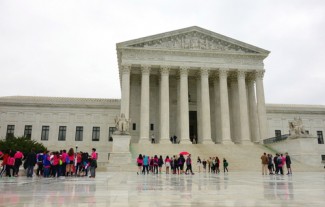Supreme Court says lawyers can't hire line-standers to get them into hearings
The U.S. Supreme Court issued a binding, nonjudicial opinion on the first day of its new session Monday when it said that lawyers could no longer hire so-called line-standers to hold places for them to get into the court to hear arguments, the Washington Post reports.
Line-standing is a significant business in Washington, offering part-time pay to those willing to stand around for hours in places such as the Capitol building and the Supreme Court. But the court said Monday that: “Only Bar members who actually attend argument will be allowed in line for the Bar section; ‘line standers’ will not be permitted.”
Not even a partner’s law-firm associate can hold a place in the so-called lawyers line. The public still can hire line-standers, though that segment of the business likely is smaller.
The use of line-standers had been increasing at the high court, with some camping out at the court for days to hold places, including for lawyers. Slate.com reported a couple of years ago that it cost about $6,000 to get line-stander admission for oral arguments on same-sex marriage.
At the lawyers line, “usually if you show up by 6 (a.m.) you’ll get in, sometimes even later,” says Pamela S. Karlan, co-director of the Supreme Court Litigation Clinic at Stanford Law School. But for arguments in the same-sex marriage cases last April, she arrived at 2 p.m. on the day before. She joined an already-long line with many people who did not look like lawyers.
Indeed, line-standing has proved to be good part-time employment for the homeless. One asked Karlan to hold his place while he went to the homeless shelter to eat. Karlan once hired a line stander for another matter.
“Court officials were aware of the increasing use of line-standers, and this new procedure attempts to end that practice,” said Kathleen Arberg, the court’s public information officer.
The court has about 400 seats, with some set aside for news media and guests of the justices. For major cases, there might be fewer than 100 seats available for the public and between 70 and 100 in the lawyers section.




